Message from the CEO : December 2017
Larry Greiner, an American Organizational Expert, paints an interesting picture of the growth stages and associated challenges for any growing organization, in his book, “Evolution and Revolution as organizations grow”. His growth model, called Greiner Growth Model, identifies 6 phases which an organization goes through, throughout its life cycle namely, (1) Growth through Creativity, (2) Growth through direction, (3) Growth through delegation, (4) Growth through Coordination and Control, (5) Growth through Cooperation, and finally (6) Growth through Alliances. The other important aspects of this model are that, organizations are always growing and expanding throughout the years, any organizational growth from one phase to the next phase is always met with resistance and this resistance is referred to as growing pains, the only variable in this model is the time factor, and lastly, at the end of each phase there will be a crisis of some sort which will compel the management to take firm decision aimed at ensuring that the organization survives the test of time.
I personally view this growth model to be a good strategic management tool as it assists you as the Business Leader, to put context to events and occurrences as they unfold within the company, something which further aids you in coming up with appropriate and sustainable solutions to associated issues and potential risks. The phases referred to above are summarized and paraphrased as follows, and he further stresses that “every phase requires different competences of the entrepreneur, something which suggests that the Business Leader has to be versatile;
(1) Growth through Creativity: This is a pioneering phase where the company is young and relatively small, informal with almost all employees being very loyal to the company. As a result of this complete loyalty by employees, the Business Leader is able to pay attention to Clients. The organizational structure is relatively flat. At some point within this phase, the company starts growing relatively fast including becoming more complex, to an extent that internal control and coordination can no longer be done by one person. Leadership Crisis becomes a reality. The Business Leader gets compelled to review the Organizational Structure for the survival of the company, something which is often met with noticeable resistance.
(2) Growth through direction: Owing to the Leadership Crisis which had been experienced towards the end of the first phase, emanating from the sudden growth and complexity of the company, a new layer of management (middle management) has to be introduced thereby amending the flat nature of the company structure to a multi-layered one. The functional managers are appointed as a result of which a middle management is created that controls the primary processes. At this stage, the rules, procedures and business processes are formalized and standardized. The central coordination still remains in the hands of the Business Leader and things still remain intact, however, as growth and complexity continues, the company gets to a point where the coordination problems become too big for the Business Leader to handle alone. It is at this point where the middle managers are expected to be given more autonomy, and this becomes the next set of crisis. This crisis compels the Business Leader to consider the next phase.
3) Growth through delegation: The main aspect of this phase is decentralization, wherein the Business Leader delegates important tasks to his middle management. Managers are given more autonomy with targets set by the Business Leader and the middle managers responsible for achieving tactical and operational objectives. The Business Leader and or Management moves at a strategic level and rarely intervenes. A division structure is created with separate product/service groups and individual managers. The main challenge of this phase is that the more divisional managers the business has, the more difficult it becomes for the Business Leader/Management Board to coordinate all the divisions that operate independently. There is a risk of a management crisis. There is a good chance that the divisional managers plot their own course too much as a consequence of which the company could break up. A good Business Leader should be able to see the associated signs of this challenge and change the trajectory, to the next level.
(4) Growth through Coordination and Control: In the standardization phase of the Greiner Growth Model, more emphasis is put on the coordination between the various units. In large diversified organizations the various staff departments take up a strong position from the headquarters from which the divisional managers are managed. When the staff departments have too much power and when there is too little scope for the divisional managers, a red tape crisis arises. The rules have made the company too inflexible and rigid. This calls for the next phase.
(5) Growth through Cooperation: In the cooperation phase of the Greiner Growth Model, cooperation between line and staff departments is aimed at and this creates a break-up of the hierarchical coordination forms such as a matrix structure or a project organization. This phase is characterized by much mutual contact between employees via all kinds of consultation groups. There is little formalization and standardization. The frequent consultations constitute a pitfall, as a result of which a consultation crisis may arise. There is every chance that supervision and control decline sharply. This could mean the end for organizations, unless they develop through external alliances, which is the last phase.
(6) Growth through Alliances: In this ‘growth through undertaking phase’ the organization only requires good external contacts and alliances. These can be found in mergers, alliances and extensive networks. Because an organization is more focused on alliances than its own core-business, there is a good chance that an identity crisis will present itself. The organization is taken over completely by other businesses and if not curbed timely, the whole organization might disappear completely.
It is our view that this Growth Model does provide a great insight into the growth phases of any organization. Naturally, organizations grow, sometimes towards planned trajectories and at times away from planned trajectories. With a good understanding of this model, each staff member can be in a good position to understand the growth level of the company, be able to identify the challenges or growing pains that are associated with that particular stage as and when they manifest themselves, and even be able to predict if not suggest the potential solutions to the Senior Management. In this way, the process of change management would be well received by all. The Management would be spared from the perception that they tend to introduce unnecessary changes to already existing and accepted status quo. I wish I was at liberty to share with you as to which growth phase that we are now at, but as this is a public document, I would prefer to leave that to you to establish, surely everyone who is part of the company should not struggle to work this one out.
With the above said, let me take this opportunity to thank all of you (the Staff), our Management Team, our clients, our community stakeholders, our professional and governing bodies, and our Board of Directors for the meaningful contribution you individually made during the year 2017. On behalf of the R&G Group of Consultants (Pty) Ltd, I wish you all, a blessed Christmas with your families and prosperous new year, and many more years to come.
I am looking forward to seeing you on the 8th of January 2018, on your return from the break.
Thank You!


